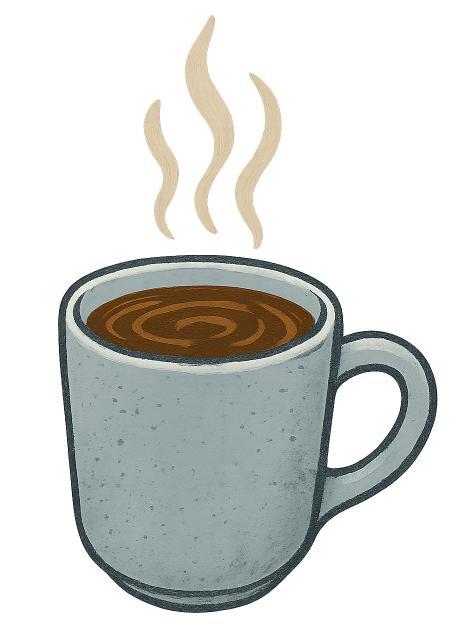Answer to Riddle #89: Coffee as hot as possible.
89. Assuming you wish to drink your coffee as hot as possible, should you add the milk as soon as you make it or just before you drink it?

I extracted this puzzle from my own thinkerator:
Before reading the answer can I interest you in a clue?
So technically:

Which means the first differential with respect to time, i.e. the rate, of energy transfer is equal to some constant to do with the physical properties of the set up multiplied by the area over which the transfer occurs multiplied by the temperature difference.
But we don't really need to worry about that, sufficient to say that a body's energy is proportional to it's temperature and the rate of change of that is proportional to the difference of it's temperature and it surroundings.
So that is the answer: If you wish to drink your coffee as hot as possible, should you add the milk as soon as you make it.
Here is a graph to show the principle:
To talk you through the graph: the blue line represents the milk in immediately the red line later. You have temperature on the Y axis and arbitrary time units along the X axis. You can see when the milk is added early and late by the associated drop in temperatures. And you can see that the temperature is highest when you put the milk inn early to minimise the the energy loss.
And here is the spread sheet I used to create the graph. If you go to 'File - Make a copy' you can create your own copy of the spread sheet and and have a play, it can be interesting to see what happens if, say, the milk is well below zero.
We're also assuming that the volume is not changed by the milk in as much as it affects the heat transfer from a geometry perspective. I believe this assumption is valid but it's debatable.
ChatGPT's AI gave very strong answer to this question, Gemini got it wrong, the first time at least. Subsequent times it was correct...
If you're curious what Gemini made of this puzzle...
If you're curious what ChatGPT made of this puzzle...
So Newton's Law of Cooling
Is a complicated name for something you may well have intuited already. The conclusion is that the rate of change of temperature is proportional to the difference in temperature of it and it's surroundings.So technically:
Which means the first differential with respect to time, i.e. the rate, of energy transfer is equal to some constant to do with the physical properties of the set up multiplied by the area over which the transfer occurs multiplied by the temperature difference.
But we don't really need to worry about that, sufficient to say that a body's energy is proportional to it's temperature and the rate of change of that is proportional to the difference of it's temperature and it surroundings.
So what does that mean for us?
It means that we can lower the rate of heat loss by lowering the temperature difference. That the final cup of coffee will be the same mixture of coffee and milk regardless of when the milk is added the only thing that can change is the energy or temperature. And the only way we can slow the rate of energy loss is by adding the milk as soon as possible.So that is the answer: If you wish to drink your coffee as hot as possible, should you add the milk as soon as you make it.
Here is a graph to show the principle:
To talk you through the graph: the blue line represents the milk in immediately the red line later. You have temperature on the Y axis and arbitrary time units along the X axis. You can see when the milk is added early and late by the associated drop in temperatures. And you can see that the temperature is highest when you put the milk inn early to minimise the the energy loss.
And here is the spread sheet I used to create the graph. If you go to 'File - Make a copy' you can create your own copy of the spread sheet and and have a play, it can be interesting to see what happens if, say, the milk is well below zero.
Assumptions...
We're assuming that the milk doesn't change the colour of the coffee! This is obviously not true. Darker things radiate heat faster than lighter things. So if you think about it this would favour our conclusion, as adding the milk in addition to reducing the temperature difference, would reduce the amount of radiation too. Nonetheless it's still something we haven't accounted for in our model.We're also assuming that the volume is not changed by the milk in as much as it affects the heat transfer from a geometry perspective. I believe this assumption is valid but it's debatable.
ChatGPT's AI gave very strong answer to this question, Gemini got it wrong, the first time at least. Subsequent times it was correct...
If you're curious what Gemini made of this puzzle...
If you're curious what ChatGPT made of this puzzle...
© Nigel Coldwell 2004 - – The questions on this site may be reproduced without further permission, I do not claim copyright over them. The answers are mine and may not be reproduced without my expressed prior consent. Please inquire using the link at the top of the page. Secure version of this page.



